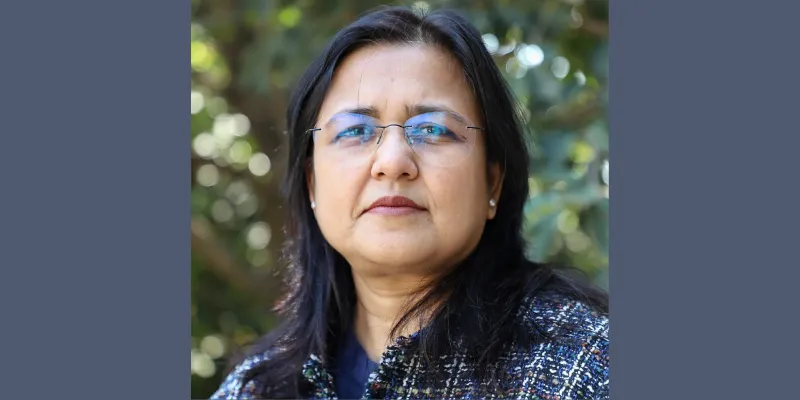[Women in Tech] Women should be exposed to different roles and responsibilities, says Manisha Banthia of Fiserv Global Services
In a career spanning 25 years, Manisha Banthia has worked with various organisations to build their analytics team. As Vice President, Data & Analytics, Fiserv Global Services, she now helps build analytics solutions that span Fiserv products and also offer advisory services for its clients.
Manisha Banthia has always been drawn to new technology spaces with a keen interest in subjects like Economics, Chemistry, and Mathematics. An Economics graduate, she also started teaching younger students from a very early age. After her graduation, she opted for an MBA degree specialising in Finance.
“This was right before the stock market scams in India came to light. I was worried I had made a wrong choice. But things revived, and I started off with National Stock Exchange of India as my first job. This was just around the time when stock trading in India was being revolutionised in a digital and more regulated way,” she recalls.

She later worked with the Infosys consulting team heading their analytics team and was instrumental in developing building analytics products, including a patent for ‘Customer Analytics for Enterprises’. During her stints at Oracle Financial Services Software (earlier iflex solutions), she built analytics solutions for Citibank (Asia Pacific), and US clients like American Stock Exchange and Country Financial. Manisha has also worked on Marketing Analytics, Financial Performance and Fraud and Risk Analytics during her tenure at MetricStream and National Stock Exchange of India.
Presently, she is Vice President, Data & Analytics, Fiserv Global Services. In a conversation with HerStory, Manisha Banthia talks about her career, and how her company is helping women rise to the top.
HerStory (HS) Were you always interested in STEM?
Manisha Banthia (BS): STEM subjects were my favourite, and while I thought I was spending more time on these because they were my highest scoring subjects, over a period of time I realised that I enjoyed everything that had a logical reasoning element to it. Be it a puzzle, mystery, thriller or a complex mathematical equation, it got me thinking and I enjoyed every bit of it. I scored a 100 percent in mathematics in high school and there was no looking back after that.
HS: Please take us through your career journey…
MB: It’s been 25 years since I started my career, and it has largely been in the data and analytics field in financial services industry. In the first three years, I was involved in analysis of capital markets trading as well as risk exposure and margin tracking at National Stock Exchange. I got an opportunity to move to banking thereafter, and as the number of data and analytics use cases multiplied I gained exposure in areas like customer and marketing analytics, financial performance, credit risk, and transaction channels analysis leading to the creation of standardised analytics solutions implemented across Citi, Asia Pacific, as well as the creation of risk solutions for Basel II as part of OFSS. Post this, I then moved to Infosys and worked towards building analytical solutions for IT services across multiple industry verticals. After having spent substantial time in product management, I decided to play a role in product marketing for risk applications in MetricStream. I joined Fiserv as Head, Analytics thereafter.
HS: Tell us about your role at Fiserv Global Services?
MB: At Fiserv, I lead a Data and Analytics practice. We build analytics solutions that span Fiserv products and also offer advisory services for Fiserv clients. We have specialised offerings across AI, ML, business intelligence and visualisation, digital user journey analytics and market intelligence. Data was added to the analytics portfolio recently to offer combined data management and analytics solutions. We cover multiple business areas like customer lifecycle analytics, merchant lifecycle analytics, cards analytics, fraud and dispute management analytics, and operations optimisation analysis. Some of our use cases include - ATM optimisation, cross sell analytics for mortgage portfolio and product feature preference using conjoint analysis.
HS: How did you face the challenges of working in a pandemic?
MB: At Fiserv our global wellness programme, Fuel Your Life, offers a holistic approach, and focuses on the physical, financial, social and emotional well-being of people. This helped all of us bring our whole selves to work during these unprecedented times. Furthermore, Fiserv is committed to the wellbeing, safety and security of all associates with some key initiatives
- Financial assistance offered to associates facing hardship emerging from the pandemic
- 24x7 Employee Assistance Program that provides 24x7 support to our associates.
- Enhanced insurance benefits
- Covid-19 Vaccine Inoculation Support for all our associates
Also, I ensured taking out personal time and got myself involved in activities close to my heart - doodling, listening to audio books and learning photography.
HS: What more can be done to attract women and retain them in the workforce.
MB: More and more initiatives are being designed for women returning to work after a career break. Fiserv has launched one such initiative recently – ForwardForHer. Women have multitasking capabilities which should be leveraged by giving them exposure to different roles and responsibilities.
HS: Do you mentor women in tech?
MB: Yes, I am involved in several key initiatives within Fiserv like Pitch Perfect and other mentoring programmes focusing on women. I am also part of the Women’s Impact Network, an ERG (employee resource group) with a focus on facilitating the development of our women professionals and offering them a platform for better exchange of ideas. I also actively involve myself with Fiserv Gives Back education initiatives for underprivileged women.
HS: Why do you think there are very few women in leadership positions in tech?
MB: Opportunities and exposure for women in technology were limited in the past. Some of the steps that organisations can take to encourage more women leaders in technology include:
- Capitalising on digital acceleration and an increased demand for tech services by building a pipeline for more women to enter the tech workforce.
- Supporting organisations and initiatives that focus on helping women get more opportunities in the IT space.
- Retaining women in tech with long-term intervention programmes to ensure continuous skill-building, mentoring and coaching.
- Reducing entry barriers for women returning to work after time away.
- Women leave the workforce for varied reasons such as elder care etc. Returning to work after a career break is more arduous for women who are techies due to lesser opportunities and redundant skills.
- Companies benefit from having diversity in their workforces, and digital competencies are helping to close the gender gap between men and women, broadening career prospects.
HS: Why should every organisation have an equal opportunity mindset?
MB: Fair work cultures encourage initiatives that promote an inclusive work environment while elevating talent and capabilities. Some of the initiatives at Fiserv include:
- Women Impact Network ERG - employee Resource Groups are a forum for associates and allies to exchange ideas, support each other and elevate professional development
- Our LGBTQ+ group drives exciting programmes, connects and learning opportunities.
- Inclusive Leadership - Senior leaders participate in our Inclusive Leader coaching programme, an assessment-based programme rolled out to all managers globally to drive awareness and expectations around building an inclusive environment.
HS: Who/What have been your biggest inspirations?
MB: Who: My mother who has never stepped down, and has broken barriers to move on the right path.
What: The book Jonathan Livingston Seagull by Richard Bach inspired me to soar high and not be complacent in life.
HS: What are your future plans?
MB: In addition to learning and upskilling to stay ahead of the curve, I plan to have my own startup and continue working with non-profit organisations to teach children and women.
Edited by Anju Narayanan


![[Women in Tech] Women should be exposed to different roles and responsibilities, says Manisha Banthia of Fiserv Global Services](https://images.yourstory.com/cs/4/8e7cc4102d6c11e9aa979329348d4c3e/Untitleddesign24-1620560762469.png?mode=crop&crop=faces&ar=2%3A1&format=auto&w=1920&q=75)





